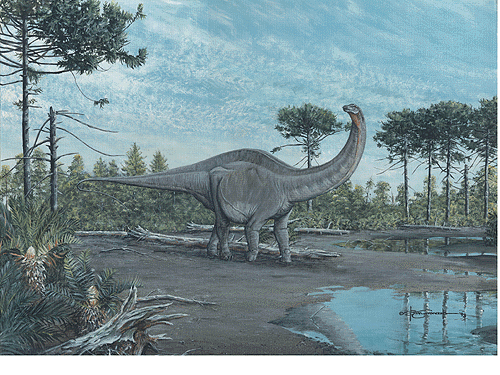

Seventy-plus feet in length and weighing 20-odd tons, the late Jurassic
diplodocid sauropod Apatosaurus louisae -- shorter-necked relative to Diplodocus
and Barosaurus -- is one of four described species of the genus
Apatosaurus (the others being A. ajax, A. excelsus, and
A. yahnahpin ). The original material for the genus was collected from
the Colorado Morrison Formation in the late 1800s by Arthur Lakes and later
named and described by O.C. Marsh. That and other original specimens of
Apatosaurus were sketchy and incomplete; subsequent finds provided better
material and a good picture of the animal began to emerge. But Marsh confused
things by naming the newer specimens Brontosaurus , a name that still
haunts this dinosaur despite the fact that it has been proven that the original
and later material are all from the same animal, thus giving the name
Apatosaurus precedence. Also confusing things was the skull originally
assigned to the skeleton: because sauropod skulls are rarely found in
articulation with the rest of the skeleton, Marsh gave his sauropod a
Camarasaurus -type head, using a skull found four miles from the rest of
the skeletal remains. In 1909, Apatosaurus louisae was unearthed near
Jensen, Utah by Earl Douglass; this almost complete, articulated skeleton was
accompanied by a somewhat smaller second individual, this specimen possessing a
diplodocid-type skull. There was resistance to using this skull with the rest of
the mounted skeleton, however, and it wasnÆt until 1978 that Berman and McIntosh
resolved the issue of the sauropodÆs true appearance and relationships. Unlike
other sauropods, Apatosaurus skeletons are rare and not usually found in
association with other members of their species, leading paleontologists to
speculate that these dinosaurs were solitary rather than herd animals. Stoutly
built, Apatosaurus was likely capable of rearing onto its hind legs --
balanced tripod-like on the base of its tail -- to forage high into the conifers
so common in its environment, where it used its peg-like teeth to scrape plant
material into its mouth. Lacking cheeks and grinding teeth, the fodder was
simply swallowed; polished stones in the gizzard ground the plants up to aid in
digestion.
Illustration ® 1993/2000 Brian Franczak
Text ® 1998 Brian
Franczak